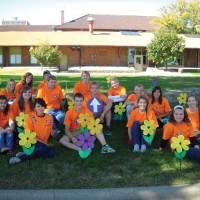Alzheimer's Association Aims to Put Itself Out of Business
- Details
- Published on Monday, 03 September 2012 14:37
- Written by Paul Gordon
The bad news is that without preventive medicine, the number of people diagnosed with Alzheimer's Disease will triple by the year 2050, to 16.5 million.
That's because the baby boomer generation is just now reaching the normal ages the devastating disease is diagnosed.
The good news is, many researchers believe such preventive medicine, or at least a treatment to slow the progression of Alzheimer's, will be available by 2025.
It's because of that belief that the Alzheimer's Association, including the Peoria chapter that covers 20 counties in Illinois, is getting more aggressive in its plan to raise money for research while planning programs such as Train the Brain to help stem the deterioration of the human brain.
The association also continues to do as much as possible for the afflicted and their families and caregivers, said Nikki Vulgaris-Rodriguez, executive director of the Central Illinois Chapter, which this year is celebrating its 25th anniversary.
"Everyone knows what Alzheimer's Disease is. Most know what a wicked disease it is. But there is still a need to increase the public's knowledge about it, including the strides made in treatment and how we can help families of those with the disease," she said.
Talking about the Walk To End Alzheimer's, the association's signature fundraising event, Vulgaris-Rodriguez said, "It really is a movement. There is a lot of education packed into the event because we have to increase awareness."
While September is World Alzheimer's Month, the association's Central Illinois Chapter sponsors eight Walk To End Alzheimer's events each year, all during August, September and culminating in the Peoria walk the first Sunday in October.
Three walks are on Saturday, Sept. 22, in Pekin, Dixon and Galesburg, while the Macomb event is Saturday, Sept. 15.
Friday, Sept. 21 is Alzheimer's Action Day and the public is asked to wear purple that day because purple is the color of the Alzheimer's movement.
The association also plans fundraisers throughout the year, events such as a pork chop sandwich sale and a dance at a local winery.
"We know people throughout the region are becoming increasingly aware of our efforts. We have to keep it up. There are a lot of not-for-profit agencies that need help and we all have to make ourselves known," she said.
Angela Green, director of public relations for the central Illinois chapter, said the Peoria region, despite covering 20 counties and 880,000 people, is one of the smaller Alzheimer's Association chapters in the country. "But we've had a lot of successes," she said.
Indeed, added Vulgaris-Rodriguez, the central Illinois chapter has performed better than chapters two or three times its size, according to benchmarks set by the national association. In the last fiscal year, which ended last month, the local chapter had approximately 19 million media impressions; its goal for the year was 3 million.
A media impression is counted anytime the media mentions the association, including paid advertising, Green said. "But our advertising budget is pretty modest. We're just doing all we can to get the word out," she said.
Vulgaris-Rodriguez said while most people know Alzheimer's to be a devastating disease, "many don't really understand it. For example, it is not a normal part of aging, as many believe. Also, Alzheimer's is hereditary from the mother's side."
She said more and more younger people are being diagnosed with early onset. "What many don't realize, though, is that the disease starts on a person seven to 10 years before the diagnosis is ever made," she added.
The Alzheimer's Association, Vulgaris-Rodrigues iterated, is as much about the caregiver as it is the afflicted. "So often we see people try to take care of their loved ones until they just can't cope any more. We encourage people to contact us early on in the process so we can help. There are financial and legal aspects that nobody thinks about until it's right upon them and we help people learn how to engage their loved one's doctors in helping to manage their care.
"This has to be a partnership," she added. "There is so much stress on the caregiver that often the caregiver passes away before the person with the disease. Let us help you navigate those waters."
And still the family care giver is no longer the primary consumer of the services the Alzheimer's Association provides. It is the patient, who because of earlier diagnoses is able to be more involved in developing treatment plans. "We're are finding they want to be involved in their care while they are still able to, including knowing what challenges they will be facing each step of the way," she said.
The association was given a boost in January 2011 when President Obama signed into law the National Alzheimer's Project Act that calls for the coordination of research into Alzheimer's and education about the disease.
The act led to the adoption in May 2012 of the National Alzheimer's Project Plan, which among other things sets goals for improving financial support for family caregivers. It is estimated families are providing $210 billion in unpaid care for patients with Alzheimer's and other dementias. That's largely because before, a caregiver had to be certified to be funded.
The association also is looking for people to volunteer for clinical trials for research purposes. Part of the trial would determine if the person is a candidate for the disease. "Some just don't want to find that out. But we need the volunteers so we can improve the chances of finding a cure or at least a way to prevent it," Vulgaris-Rodriguez said.
There remains a stigma to having Alzheimer's disease and 25 percent of those who have been diagnosed with it still live alone. But with education that stigma is dissolving as people realize Alzheimer's can affect anyone, no matter their race, income or education level. Women are at higher risk.
"It is the only disease in the top 10 causes of death in world that cannot be prevented or slowed. Every 68 seconds somebody develops the disease and that time goes down every year. Last year, it was every 70 seconds," Vulgaris-Rodriguez said.
"It is a wicked, wicked disease."
KNOW THE SIGNS
The 10 main signs of Alzheimer's Disease, according to the Alzheimer's Association.
- Memory changes that disrupt daily life.
- Challenges in planning or solving problems.
- Difficulty completing familiar tasks.
- Confusion of time or place.
- Trouble understanding visual images and spatial relationships.
- New problems with words in speaking or writing.
- Misplacing things and losing the ability to retrace steps.
- Decreased or poor judgement.
- Withdrawl from work or social activities.
- Changes in mood and personality.
The Alzheimer's Association offers patients, their families and caregivers a 24-hour helpline where they can get confidential answers to their questions about the disease. That number is (800) 272-3900.
For more information about The Walk to End Alzheimer's, including forming a team, visit www.alz.org/illinoiscentral



















































